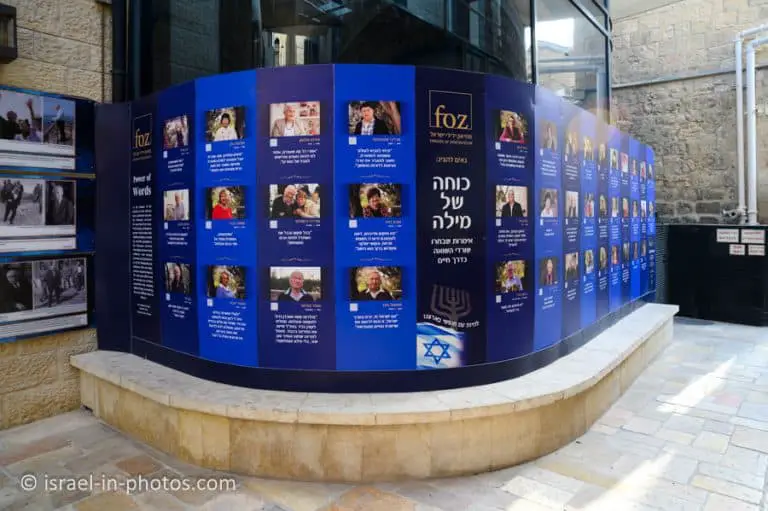The Museum for Islamic Art, Jerusalem – Visitors Guide
The Museum For Islamic Art guide in Jerusalem presents various Islamic art findings from different periods and places.
Table of Contents
- 1 Map
- 2 Directions
- 3 Opening Hours
- 4 Entrance Fee
- 5 Accessibility
- 6 L.A. Mayer Institute for Islamic Art
- 7 About the Museum
- 8 Workshops for Kids and Adults
- 9 Ground Floor – Introduction to Islamic Religion and Art
- 10 Second Floor – Late Art
- 11 Underground Floor – Watches Collection and Temporary Exhibitions
- 12 Summary
Map
The Museum for Islamic Art is located at HaPalmach Street 2, Jerusalem.
Directions for drivers: Link to Waze and Link to Google Maps
Directions for public transport: Link to Moovit
Interactive map of the area:
The museum is relatively small. It has three floors with three halls on each floor. Here is the floor plan:
You can also find this map here.
Something that I liked, and you rarely find on maps in museums, is that besides the name of each hall, you can see the estimated time of a visit. And you can also see that exhibitions have numbers beside them. That is the recommended visiting order. We followed the suggested order and started with the exhibits on the ground floor.
Directions
You can reach the museum either by car or by public transport.
If driving, enter “HaPalmach Street 2, Jerusalem” into the navigation app. And when it comes to parking, you will probably have to look for it on nearby streets.
Street parking where the curb is either gray (free) or painted blue and white (paid), on Hapalmach Street, Hagedud Ha’ivri Street and Chopin Street.
On Saturday, the Museum parking lot is open to visitors free of charge, based on space available.
Note: unless stated otherwise, all quotes were taken from the official site.
When it comes to public transport, you can use bus #13, #32, or #15 to get there. Here is a link to Moovit, where you can update your starting point and get updated directions.
Opening Hours
Sunday: Closed
Monday – Wednesday: 10:00 – 15:00
Thursday: 10:00 – 19:00
Friday – Saturday: 10:00-14:00
Entrance Fee
Adult: 44 NIS
Child (5-18): 25 NIS
Israeli Senior: 22 NIS
Children under the age of 5 enter for free.
Opening hours and ticket prices were updated in December 2022. In any case, recheck the official site before visiting.
Accessibility
The museum is accessible.
Entrance for the disabled is via the Museum parking lot. Prior arrangement by phone is possible: 02-5661291.
L.A. Mayer Institute for Islamic Art
The Museum for Islamic Art is also called L.A. Mayer Institute for Islamic Art. Vera Bryce Salomons, the museum’s founder, gave the second name in memory of her professor, Leo Aryeh Mayer, rector of Hebrew University, a scholar of Islamic art who died 15 years before.
About the Museum
The Museum for Islamic Art in Jerusalem opened in 1974. It is devoted to the collection, preservation, and exhibition of art objects and archaeological artifacts that represent Islamic art across the ages, through conquests and regime changes, from the 7th to the 19th centuries.
In the more than four decades of its existence, the museum has earned a reputation as the home of one of the most important collections of Islamic art in the world, and the only one of its kind in Israel. The permanent display gives a broad view of, and a deep insight into, the artistic treasures of the Muslim world that extended over Egypt, Syria, Iraq, Iran, Turkey, Afghanistan and India, and west as far as Spain. These treasures – ancient pages of the Qur’an; utilitarian items of pottery, metal, and glass; and luxury items such as jewelry, ornaments, and rugs – reflect the wealth of forms and styles that characterize Islamic art.
Workshops for Kids and Adults
The museum houses Islamic pottery, textiles, jewelry, ritual objects, other Islamic cultural artifacts, and a watches collection. And I heard the story about the watch’s burglary (we will reach it later) in the news and wanted to see them. But we traveled with our daughter (she was in the first grade). And we decided to visit this museum because of the extra activities and workshops for kids. Unfortunately, we have not found anything specific on the website, but we decided to visit it anyway.
Tours
A private family tour of the permanent exhibits is available – and recommended. (Reservation is required.) Also, over the holidays and during school vacations, you are invited to take part in activities at the museum, including a high-quality children’s stage performance.
Here are the contact details of the tour coordinator: 02-5358716, khadeeja@iam.org.il
Workshops
We have a rich selection of art workshops at the museum. Why not include one in your visit? And at the end of the activity, you can take home a souvenir that you and your children have made. Workshops are about one hour long and are included in the entrance fee to the Museum.
Unfortunately, in the end, we did not participate in any workshops.
I noticed an events section when I checked the official site after our visit. You can see the full timetable of tours, lectures, workshops, and more.
Ground Floor – Introduction to Islamic Religion and Art
Ground Floor, the first floor, starts with The story of Islam.
The Story of Islam
The exhibition presents the basic concepts of understanding Islamic art through various eras. That is the only area of the museum that is not based on a chronological design. It houses rare exhibits that convey the development of the artistic idiom that is unique to Islamic art and incorporates sound and light elements. The visitors enter the hall are greeted by a movie which describes the ritual of walking around the Kaaba, and they encounter a Mihrab prayer niche made of Armenian designed ceramic tiles.
The two principal elements in the exhibition are an artistic section in a religious context and a part that focuses on the contribution of Islam to the world relating to the sciences, technology music and other areas.
The main hall on the first floor tells about Islam and shows various artifacts, including art pieces, technological items, musical instruments, and early writings.
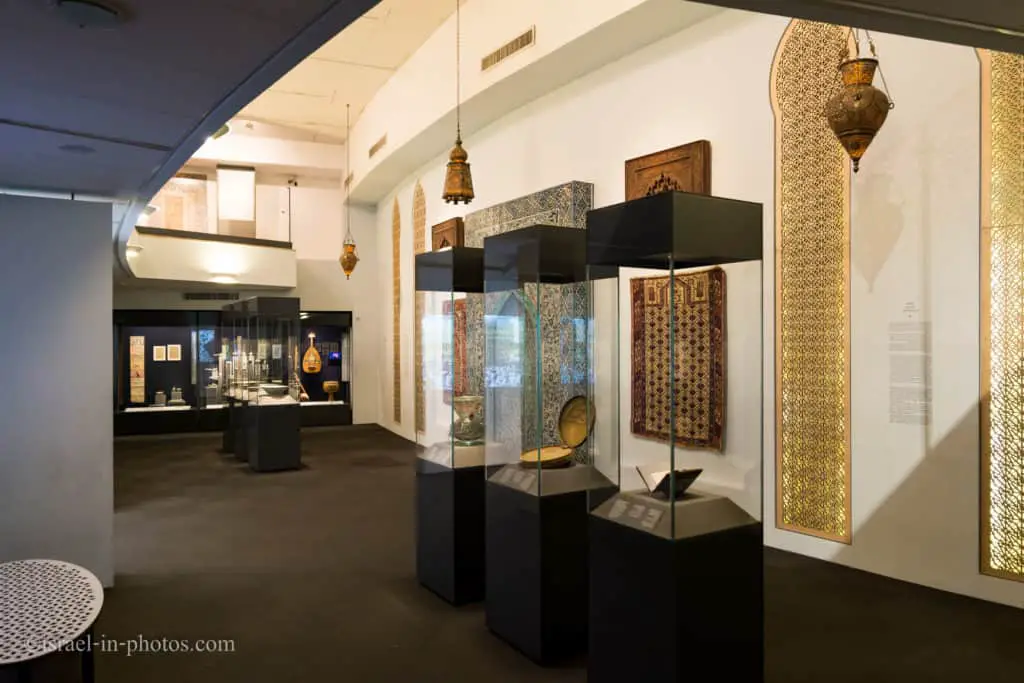
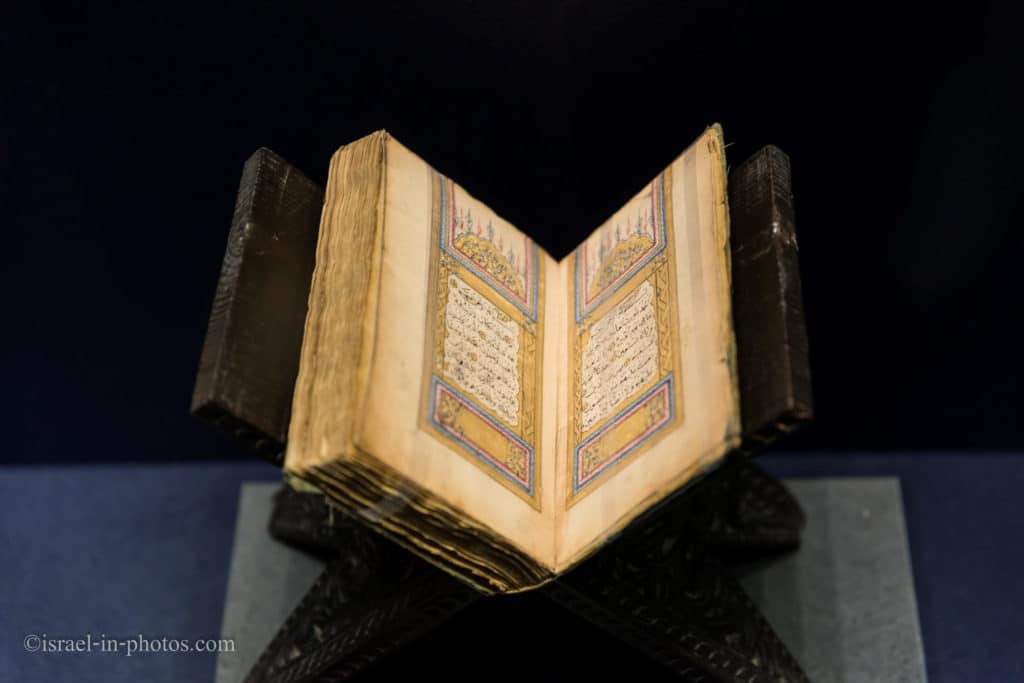


Examples of ancient writings:

And this is a Qibla indicator and a compass. The painted wooden instrument has a needle, which indicates the direction to Mecca, and a compass. The inside of the lid shows a depiction of Mecca and the Kaba. And at the bottom, there is a world map with a list of cities and countries.
This instrument originated in Istambul, and it is dated to 1738.

Here is the Oud. The oud is a short-neck lute-type, a pear-shaped stringed instrument with 11 or 13 strings grouped in 5 or 6 courses. It is Arab music’s most important instrument and the ancestor of the modern guitar.

And if you love music and old instruments, check out Hebrew Music Museum in Jerusalem.
The Harari Hoard
The Harari Hoard is a rare treasure that belonged to collector and scholar Ralph Harari. The collection includes 20 silver items from the 11th and 12th centuries. This collection is unique since the vessels are made from silver (thus in excellent condition) and not bronze or brass as accepted in Islam.
The hoard was discovered in a large pitcher in northern Iran, in the city Nohawad. The treasure trove, which includes perfume bottles, incense vessels, jewelry boxes, drinking utensils, small bowls, and horse harnesses, was probably buried by a merchant who, for some unknown reason, was forced to dispense with it. The items in the hoard were made in a variety of styles, and it appears they were made in different workshops and acquired in the Khurasan region of eastern Iran. Their decorative techniques also cover a range of styles: engraving, relief, niello settings, and gilding. The decorative features of the items in the hoard are consistent with the features of Islamic art: inscriptions, arabesques, filigree, figures of animals and birds.

This Astrolabe was made in 1727 in North Africa. The astrolabe is used to determine the direction to Mecca, the time of prayers, and the horoscope.

Chess
Chess evolved in India and reached Europe with the Arabs after conquering Iran in the 7th century. And as chess traveled through continents, it changed some of the figures. For example, the queen (vizier) is the piece that changed its sex and character in the 12th century. This change occurred since the position of the vizier, a high-ranking political advisor or minister, was unfamiliar in Europe.

Early Islamic Art
In the 7th and 8th centuries, an eclectic style of art developed in the lands conquered by the Arabs. It was based on widespread pre-Islamic traditions, amongst them Coptic, Byzantine, and Sassanid, with pagan and Christian elements replaced by new interpretations of old motifs. Muslim artists and craftsmen learned from their local counterparts techniques of painting, coating and decorating ceramics, and the manufacture and decoration of glassware and metalware.


Midway through the Abbasid period, the attention shifts to the Samanids (874-999), an Iranian dynasty that had declared its independence. This culture was renowned for its extraordinary pottery, created for the most part in two cities, Samarkand and Nishapur, which were already important centers that supplied woven fabrics, metalware, glass, and chess pieces across the empire.
The potters developed a technique for achieving the remarkable colorfulness of their ceramics. Before the firing and glazing of the vessel, it was covered by a mixture of pigments, clay, and earth. Another type of vessel employed a white background, with decorative calligraphy – in general, the name of Allah or a blessing – in purple or some other dark color.
Art in The Middle Ages
The Seljuqs were a Turkic dynasty that infiltrated and ultimately controlled Iran and Anatolia in the 11th century. Their rule saw an enormous wave of construction throughout their realm.
Apart from architecture, pottery was the dominant art form of the empire, characterized by a colorfulness and luster that had developed far beyond similar techniques in the past. The two great art centers of the period were Kashan and Reyy.
Kashan was a city in Iran. It was famous for its pottery and tiles. The word Kashi means pottery and is also a synonym for the word tile. And these are Kashan Tiles. They were used for decorating mosque walls, mausoleums, private houses, and palaces.

Here is a brass silver bowl from the Ayyubid and Mamluk periods (14th century, Egypt or Syria).
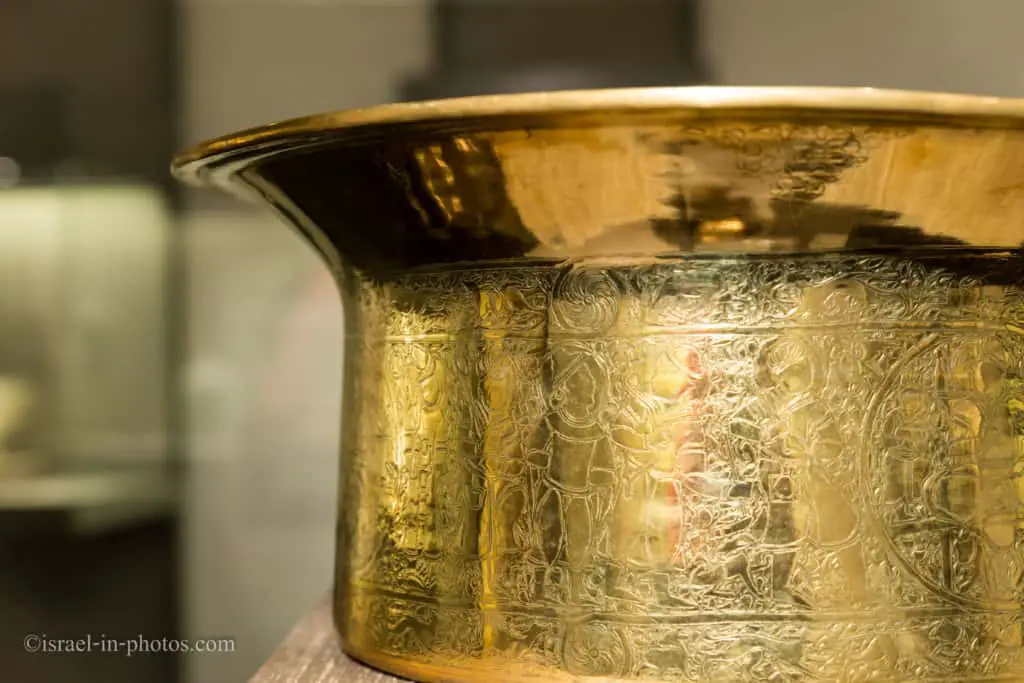
Second Floor – Late Art
Ottoman Art
The Ottoman Empire, at its height, extended from Iraq in the east, to Vienna in the west, and North Africa to the south-west. Its beginnings lay with the defeat of the Byzantine Empire by Ottoman Turkish forces, the capture of Constantinople, and the change of its name to Istanbul. That capital city became a center of culture, architecture, and art, under the enthusiastic patronage of the sultans – at least until the mid-17th century.
In the beginning, the Ottoman artists added local artistic traditions to their Chinese and Iranian repertoire. In the 16th century, a Chinese-Buddhist motif of leaves was added to the old ones of arabesques, tendrils, flowers, and birds. Toward the end of the 17th century, European influences began to infiltrate Ottoman art, giving rise to a style that became known as Turkish Rococo.
Damascus Ware
Iznik, a town in Turkey, flourished between the years 1490 and 1525. It became the center for the production of Ottoman pottery. The decorations are in blue and turquoise in Chinese fashion, and some are decorated with Chinese lotuses. Later on, they added purple and green colors, and this was called “Damascus ware.”

Today, you can still find Turkish-style workshops in Jerusalem which create Ottoman ceramics.

Moghul Art
The penetration of Islamic culture into India began in the 7th century, with the Muslim conquest of broad areas of the Subcontinent. In the following centuries, Islamic art took hold in India as a result of historical events, like the invasion of Turkic nomads, or the establishment of various Muslim dynasties. In 1192, Delhi became the capital of a unified Muslim-Indian empire. It collapsed with the conquest of the region by Timur and the founding of the Timurid empire.


Probably the most famous representative of Moghul art is the Taj Mahal.
Underground Floor – Watches Collection and Temporary Exhibitions
Watches Collection
I enjoyed the exhibitions, but Sir David Salomon’s Collection of watches and clocks was my favorite.

Sir David Salomons (1851 – 1925), father of Vera Bryce Salomons, the museum’s founder, assembled a rare collection of watches and clocks. The workshop of Abraham-Louis Breguet, a French master watchmaker, created 60 of these watches.

And this is the rolling ball clock. In this type of watch, the time is measured by the time it takes a small steel ball clock to roll down an inclined plate. When the ball reaches the end of the plate, it inclines in the opposite direction, and the ball starts to roll back.

This movement was invented in the late 16th century, and it is based on Galileo’s law that bodies on an inclined surface will cover a given distance in a constant period.
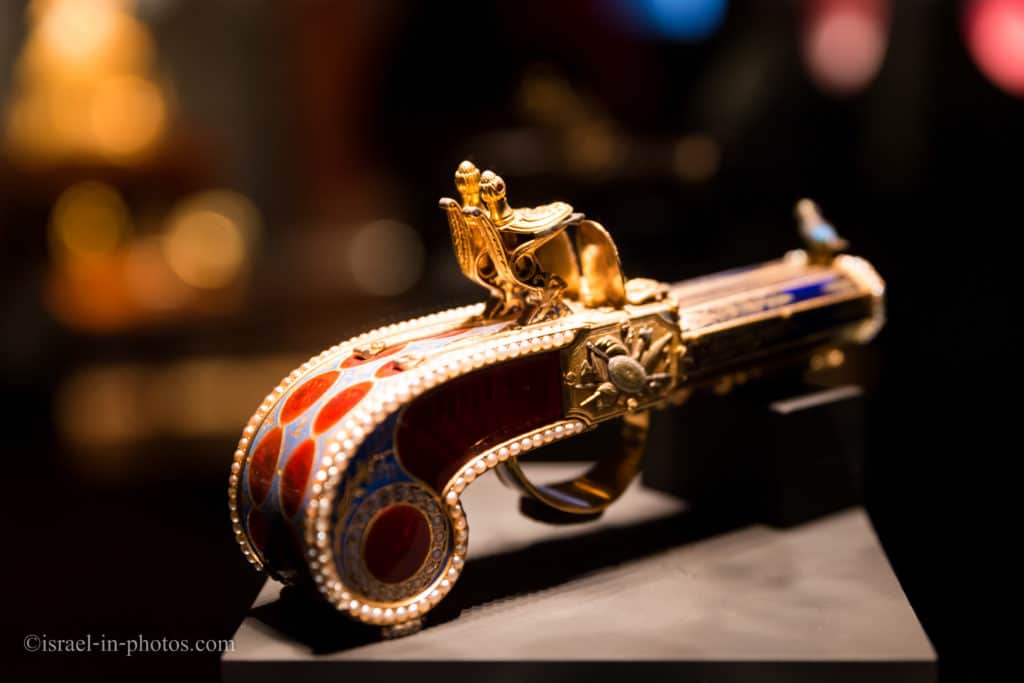
Marie Antoinette Watch
The Breguet No. 160 grand complication, more commonly known as the Marie-Antoinette or the Queen, is a case watch designed by Swiss watchmaker Abraham-Louis Breguet. It has been called ‘a poem in clockwork’. Work on the watch was begun in 1782 and completed by Breguet’s son in 1827, four years after Breguet’s death.
The watch is thought to have been commissioned in 1783 by Count Hans Axel von Fersen, an admirer, and alleged lover of the French Queen, Marie Antoinette.
It took almost twenty years to complete. Marie Antoinette never lived to see the watch, as it was finished 34 years after she died.
In 2013, the watch was valued at $30 million.
Source: Wikipedia


It includes gold, platinum, rubies, and sapphires. It has every watch function known at that time (clock, perpetual calendar, minute repeater, thermometer, chronograph, power reserve, Pare-Chute, chime, and independent seconds hand).
The Burglary
On 15 April 1983 some 200 items, including paintings and dozens of rare clocks and watches, were stolen when the museum was burgled. Among the stolen timepieces was the watch known as the “Marie Antoinette,” the so-called “Mona Lisa” of watches, and the crown jewel of the watch collection, made by the famed French-Swiss watchmaker Abraham-Louis Breguet reputedly for Queen Marie Antoinette, and estimated to be worth US$30 million. It was part of a unique collection of 57 Breguet timepieces donated to the museum by the daughter of Sir David Lionel Salomons, one of the leading experts on Breguet.
At the time, evidence at the scene led to speculation that at least four burglars had committed it, but in the late 2000s, Israeli police arrested Naaman Diller, who had committed some burglaries and bank break-ins in the 1960s and 1970s. Diller had acted alone after discovering that the museum’s alarm system was not working and the guard was posted at the front of the building. Behind the cover of a parked truck, Diller used a crowbar to prise apart the bars on a rear window. Items he could not remove in one piece were dismantled. Diller stashed many of the stolen items in safety deposit boxes in Europe and the USA, before settling in Los Angeles.
Source: Wikipedia

The Breakthrough
The case remained unsolved for more than 20 years. And in August 2006, a Tel Aviv antique appraiser contacted the museum and reported that some of the stolen items were being held by a Tel Aviv lawyer whose client had inherited them from her deceased husband, and who wished to sell them back to the museum. The original asking price was US$2 million, but this was negotiated down to US$35,000. Among the returned items was the “Marie Antoinette” and a valuable “Sympathique” clock, also by Breguet.
A later search of a warehouse in Israel produced documents that led to safety deposit boxes owned by Diller in Israel, Germany, the Netherlands, and the United States. Police identified the client as Nili Shamrat, an expatriate Israeli who had married Diller in 2003. She told police that just before her husband’s death in 2004, he confessed and advised her to sell the collection. Shamrat was arrested in May 2008 after a house search by Israeli and American investigators found several of the stolen clocks, some rare 18th-century paintings and catalog cards bearing the name of the watches and their manufacturers.
On November 18, 2008, French and Israeli police officials discovered 43 more stolen timepieces in two bank safes in France. Of the 106 rare timepieces stolen in 1983, 96 have now been recovered.
Source: Wikipedia
Here are several additional photos of the watches collection:



Summary
We visited this museum for about two hours. And despite its size, there are many beautiful things to see. And I enjoyed this visit a lot.
As for workshops for kids, we have not seen any during our visit. Thus, if you are coming with children, or want to join some activity by yourself, check out the workshop section.
For nearby attractions, including other museums, see Jerusalem.
Have you ever been to the Museum For Islamic Art? Tell us about your experience in the comments below.
That’s all for today, and I’ll see you in future travels!
Stay Tuned!
Additional Resources
Here are several resources that I created to help travelers:- Trip Planner with Attractions and Itineraries is the page that will help you create your perfect travel route.
- What is the Best Time to visit Israel? To answer this question, we will consider the weather, prices, holidays, festivals, and more.
- Information and Tips for Tourists to Israel will answer the most common questions tourists have about Israel (including safety, passports, weather, currency, tipping, electricity, and much more).
- Israel National Parks and Nature Reserves include a complete list, top ten, map, tickets (Israel Pass, Matmon, combo), and campsites.
- If you are looking for things to do, here are the pages for Jerusalem, Tel Aviv, Haifa, Sea Of Galilee, Akko (Acre), Eilat, Nazareth, Safed (Tzfat), and Makhtesh Ramon.






